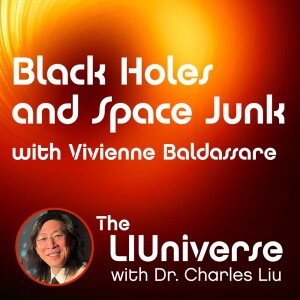
Saturday Nov 18, 2023
Black Holes and Space Junk with Vivienne Baldassare
How do we find black holes? And how can we tell whether it’s a small black hole “eating” really fast or a large black hole that’s eating very slowly? To find out, Dr. Charles Liu and co-host Allen Liu welcome astrophysicist Dr. Vivienne Baldassare, a professor of astronomy and physics at Washington State University.
As always, though, we start off with the day’s joyfully cool cosmic thing, the recently published composite photo of the X-ray Binary System in nearby starburst galaxy NGC_4214. Vivienne explains how X-ray Binaries, which are relatively rare, are created by a stellar mass black hole or a neutron star being fed by a star.
Chuck and Vivienne discuss the differences between using the new James Webb Space Telescope and “old tech” like the Hubble Space Telescope and the Chandra X-ray Observatory, and how she uses Chandra to find black holes. Professor Baldassare explains how she uses x-ray observations, optical spectroscopy, and variability data to find intermediate-mass black holes, which she is one of the first astronomers to find. You’ll hear about the differences between stellar mass black holes, supermassive black holes, and the intermediate-mass back holes that fit somewhere between.
Then it’s time for our first student question, from Lorenzo, who asks, “Are stars only found in galaxies, and if not, where else?” Vivienne explains that most stars are found in galaxies, but they can also be found in globular clusters. There are also hyper-velocity stars, which can be found in the halo of our galaxy on their way to escape our galaxy entirely.
A discussion of the Chandra X-ray Observatory, which spends about 80% of its time outside the Van Allen belts, turns into a discussion about all the manmade objects orbiting the Earth, including Chandra, Hubble, satellites... and lots of space junk, too. We’ve currently got about 8,000 satellites orbiting Earth – a surprising amount of which are SpaceX Starlink satellites, with more “satellite constellations” planned by SpaceX and others. You’ll find out about the risk of chain-reaction debris collisions due to solar storms and other disruptive events, Kessler Syndrome, the environmental consequences of mostly-aluminum satellites burning up in our atmosphere, and the first fine every levied for space junk, against Dish Network.
For our next student question, Adrian wants to know how tiny black holes can swallow super giant stars? Vivienne explains how tidal disruption, when the gravity on one side of an object is greater than on the other side, can pull a star apart in months or even weeks!
Finally, Vivienne talks about being an ultra-marathon runner and a trail runner, hiking with her dog, and the importance of being able to go out to wild spaces in nature. Chuck gets here to share a favorite hiking memory – a 7-day, long distance solo hike around Mt. Blanc after presenting her work at a conference in France.
If you’d like to know more about Dr. Baldassare, you can follow her on Twitter @vbaldassare, Instagram @vbaldassare, or her website which includes her email for you to reach out to her and ask her more questions.
We hope you enjoy this episode of The LIUniverse, and, if you do, please support us on Patreon.
Credits for Images Used in this Episode:
– NGC_4214 (X-ray binary circled) –NASA, ESA and the Hubble Heritage Team (STScI/AURA)-ESA/Hubble Collaboration, Public Doman
– Artist’s impression of an X-ray Binary – Dana Berry/NASA Goddard Space Flight Center, Public domain
– Launch of Hubble on shuttle flight STS-31 – NASA, Public Domain
– Illustration of the Chandra X-ray Observatory – NASA/CXC/NGST, Public Domain
– Our Milky Way’s central black hole – EHT Collaboration, CC BY 4.0
– Globular cluster NGC 1466 – ESA/NASA (Hubble), Public Domain
– Orbit of the Chandra X-ray Observatory – NASA, Public Domain
– Starlink trails on a CTIO telescope image – NSF’s National Optical-Infrared Astronomy Research Laboratory/CTIO/AURA/DELVE, CC BY 4.0
– Diagram of tides in Earth’s oceans – Orion 8 on Wikimedia Commons, Public Domain
#TheLIUniverse #CharlesLiu #AllenLiu #SciencePodcast #AstronomyPodcast #blackhole #globularclusters #hypervelocitystars #XrayBinary #starburstgalaxy #NGC4214 #stellarmassblackhole #neutronstar #MilkyWayGalaxy #HubbleSpaceTelescope #ChandraXrayObservatory #supermassiveblackholes #intermediatemassbackholes #VanAllenbelts #SpaceX #Starlink #satelliteconstellations #spacejunk #satellites #KesslerSyndrome #tidaldisruption
No comments yet. Be the first to say something!